Which of the following types of cells produce and release antibodies?
Natural killer cells
Cytotoxic T-cells
Plasma B cells
Helper T-cells
Correct Answer : C
Plasma B cells.
Antibodies are produced by specialized white blood cells called B lymphocytes (or B cells).
When an antigen binds to the B-cell surface, it stimulates the B cell to divide and mature into a group of identical cells called a clone.
The mature B cells, called plasma cells, secrete millions of antibodies into the bloodstream and lymphatic system.
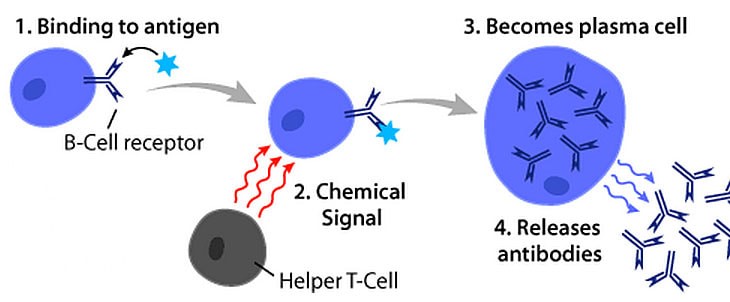
Choice A, Natural killer cells, is not the correct answer because natural killer cells are a type of white blood cell that play a major role in the host-rejection of both tumors and virally infected cells.
Choice B, Cytotoxic T-cells, is not the correct answer because cytotoxic T-cells are a type of white blood cell that kills cancer cells, cells that are infected (particularly with viruses), or cells that are damaged in other ways.
Choice D, Helper T-cells, is not the correct answer because helper T-cells are a type of white blood cell that play an important role in the immune system by helping other white blood cells fight infections.
TEAS 7 Exam Quiz Bank
HESI A2 Exam Quiz Bank
Find More Questions 📚
Teas 7 Questions: We got the latest updated TEAS 7 questions
100% Money Refund: 100% money back guarantee if you take our full
assessment pass with 80% and fail the actual exam.
Live Tutoring: Fully customized live tutoring lessons.
Guaranteed A Grade: All students who use our services pass with 90%
guarantee.
Related Questions
Correct Answer is C
Explanation
Osmosis is the movement of water molecules across a selectively permeable membrane from an area of higher water concentration to an area of lower water concentration.
In a hypertonic solution, the concentration of solutes outside the cell is higher than inside the cell, so water flows out of the cell through aquaporins embedded in the plasma membrane to balance the concentration gradient.
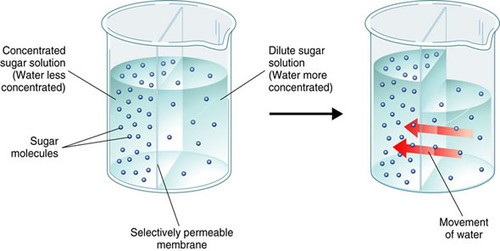
Choice A.
Facilitated diffusion is not correct because it is a type of passive transport that involves the movement of molecules across a membrane through specific transport proteins, but it does not specifically refer to the movement of water molecules.
Choice B.
Active transport is not correct because it is a type of transport that involves the movement of molecules against their concentration gradient and requires energy in the form of ATP, but osmosis is a passive process that does not require energy.
Choice D.
Diffusion is not correct because it refers to the movement of molecules from an area of higher concentration to an area of lower concentration, but it does not specifically refer to the movement of water molecules.
Correct Answer is C
Explanation
A tsunami is a catastrophic ocean wave that is usually caused by a submarine earthquake.
It can also be caused by an underwater or coastal landslide, the eruption of a volcano, or the impact of a meteor or comet in a body of water.
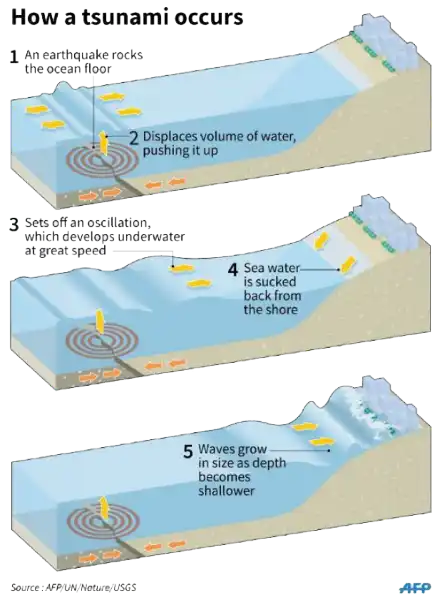
Choice A is not correct because sunspot activity does not cause tsunamis.
Choice B is not correct because lightning strikes do not cause tsunamis.
Choice D is not correct because flooding does not cause tsunamis.
Correct Answer is A
Explanation
The cell membrane is present in both prokaryotic and eukaryotic cells.
The cell membrane is a thin, flexible barrier that surrounds all cells and separates the inside of the cell from the outside environment.
It is composed of a lipid bilayer and regulates the movement of substances into and out of the cell.
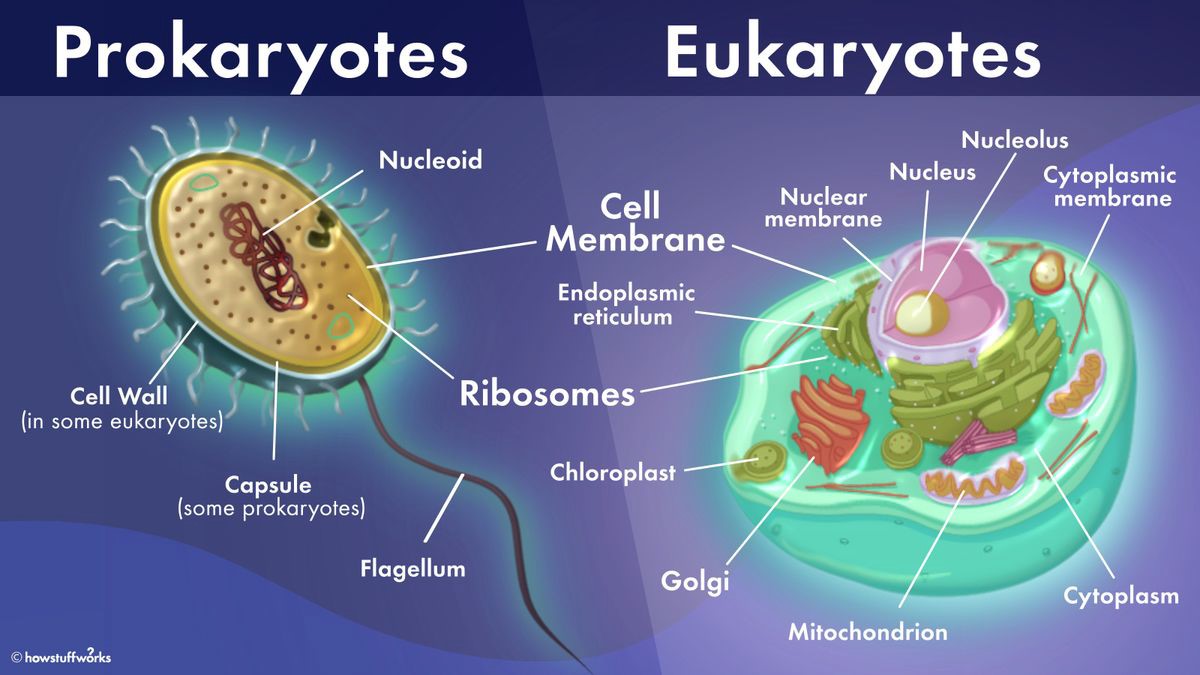
Choice B is incorrect because the Golgi apparatus is not present in prokaryotic cells.
The Golgi apparatus is an organelle found in eukaryotic cells that is involved in modifying, sorting, and packaging proteins and lipids for transport to other parts of the cell or to be secreted outside the cell.
Choice C is incorrect because chloroplasts are not present in prokaryotic cells.
Chloroplasts are organelles found in plant cells and some algae that are responsible for photosynthesis.
Choice D is incorrect because the endoplasmic reticulum is not present in prokaryotic cells.
The endoplasmic reticulum is an organelle found in eukaryotic cells that is involved in protein synthesis and lipid metabolism.
Correct Answer is C
Explanation
Bag mass change is the dependent variable in this experiment.
In an experiment, the dependent variable is the variable that is being measured and is expected to change in response to changes in the independent variable(s).
In this case, the bag mass change is being measured and is expected to change in response to changes in the independent variable (sucrose concentration).
Choice A is incorrect because duration is not a variable in this experiment.
Choice B is incorrect because temperature is not a variable in this experiment.
Choice D is incorrect because sucrose concentration is an independent variable, not a dependent variable.
An independent variable is a variable that is manipulated by the experimenter to see how it affects the dependent
Correct Answer is C
Explanation
Carbonic acid.
In the human body, maintaining the pH of the blood within a narrow range is critical for proper physiological functioning.
One of the buffering systems that helps to regulate blood pH involves the conversion of carbon dioxide (CO2) and water (H2O) into carbonic acid (H2CO3), which then dissociates into hydrogen ions (H+) and bicarbonate ions (HCO3-).

Carbonic acid (H2CO3) is responsible for donating H+ ions to act as a buffer when blood pH rises.
When blood pH rises (becomes more alkaline), carbonic acid dissociates, and the H+ ions combine with bicarbonate ions to form more carbonic acid.
This helps to remove excess H+ ions from the blood and prevent the pH from rising too much.
Option A, carbon dioxide, is involved in the buffering system through its conversion to carbonic acid.
However, it does not directly donate H+ ions to act as a buffer when blood pH rises.
Option B, carbon monoxide, is a toxic gas that binds to hemoglobin in red blood cells, preventing them from carrying oxygen.
It is not involved in the buffering system and does not donate H+ ions.
Option D, oxygen, is carried by hemoglobin in red blood cells and is essential for respiration.
It is not involved in the buffering system and does not donate H+ ions.
Correct Answer is C
Explanation
Amino acids have a unique structure consisting of an amino group (-NH3⁺) and a carboxyl group (-COO⁻) attached to a central carbon (called the α-carbon). At physiological pH (around 7.4), these functional groups often exist in their ionized forms:
- The amino group (-NH3⁺) is positively charged, acting as a proton acceptor (a base).
- The carboxyl group (-COO⁻) is negatively charged, acting as a proton donor (an acid).
This results in a zwitterion — a molecule with both a positive and a negative charge. Because amino acids can accept or donate protons depending on the pH of their environment, they have buffering capacity. This means they can resist changes in pH by stabilizing the concentration of hydrogen ions (H⁺).
Why Other Options Are Incorrect:
- A. Monosaccharides: These are simple sugars without ionizable functional groups, so they cannot act as buffers.
- B. Ribonucleotides and D. Deoxyribonucleotides: While nucleotides have phosphate groups that can donate protons, they lack the dual positive and negative functional groups necessary for the strong buffering effect seen in amino acids.
Therefore, amino acids are the correct choice because their zwitterionic nature provides them with excellent buffering capacity.
Correct Answer is A
Explanation
As a solid turns to a liquid, the particles become less ordered and more free to move around.
Choice B is not correct because particles have an increase in mobility as a solid turns to a liquid.
Choice C is not correct because particles move further apart as a solid turns to a liquid.
Choice D is not correct because intermolecular forces between particles become weaker as a solid turns to a liquid.
Correct Answer is B
Explanation
The hypothalamus is a small region of the brain located just above the brainstem. It serves as a critical control center for maintaining homeostasis — the body’s internal balance. One of its key roles is regulating core body temperature through a process called thermoregulation.
The hypothalamus monitors the body's temperature using temperature-sensitive neurons. If the body becomes too hot or too cold, the hypothalamus initiates responses to bring the temperature back to a normal range by:
- Triggering sweating to cool down the body.
- Initiating shivering to generate heat.
- Adjusting blood flow to the skin for heat loss or retention.
In addition to temperature regulation, the hypothalamus also controls other vital functions like:
- Hunger and thirst
- Sleep-wake cycles
- Hormone release (by influencing the pituitary gland)
- Stress response
Why the Other Options Are Incorrect:
- A. Pituitary gland: While the pituitary gland is known as the “master gland” because it controls other endocrine glands, it does so under the direction of the hypothalamus. It does not directly regulate body temperature.
- C. Adrenal gland: The adrenal glands produce hormones like cortisol and adrenaline, primarily involved in the stress response, not temperature regulation.
- D. Pancreas: The pancreas is mainly responsible for regulating blood sugar levels through insulin and glucagon, not body temperature.
Thus, the hypothalamus is the part of the endocrine system most responsible for maintaining homeostasis, including regulating core body temperature.
Correct Answer is C
Explanation
The two major parts of the nervous system are the Central Nervous System (CNS) and the Peripheral Nervous System (PNS).
The CNS is made up of the brain and spinal cord and acts as the integration and command center of the body.
The PNS represents the conduit between the CNS and the body and is further subdivided into the somatic nervous system (SNS) and the autonomic nervous system (ANS).

Choice A is incorrect because it only mentions two subdivisions of the PNS, which are the autonomic nervous system (ANS) and somatic nervous system (SNS).
Choice B is incorrect because it only mentions one major part of the nervous system, which is the PNS, and one subdivision of it, which is the SNS.
Choice D is incorrect because it only mentions one major part of the nervous system, which is the CNS, and one subdivision of the PNS, which is the ANS.
Correct Answer is B
Explanation
The atomic number of an element represents the number of protons in the nucleus of an atom of that element.
Since lithium has an atomic number of 3, it has 3 protons in its nucleus.
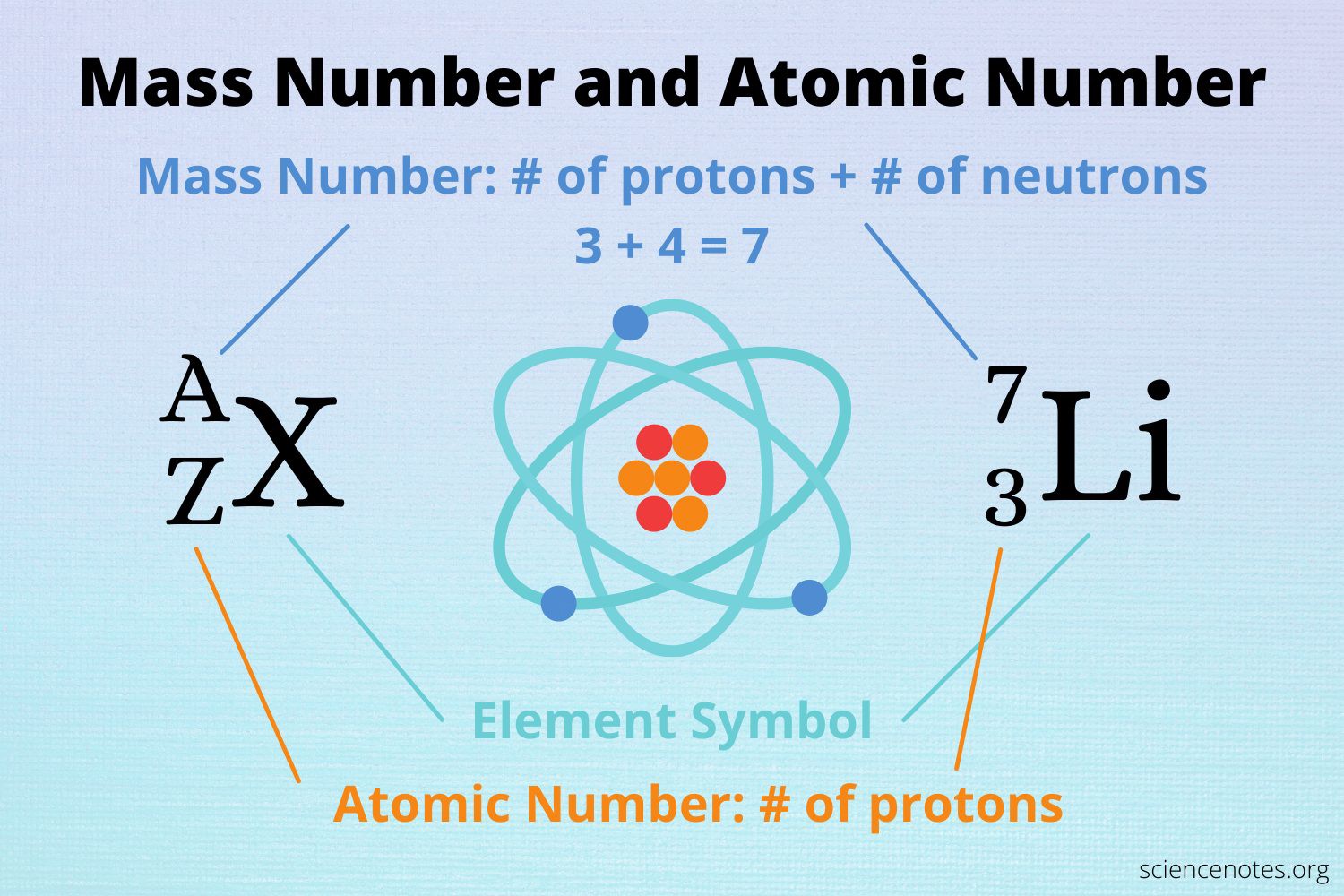
Choice A is not correct because 7 is the mass number of lithium, not the number of protons.
Choice C is not correct because 12 is not the atomic number or mass number of lithium.
Choice D is not correct because 4 is not the atomic number or mass number of lithium.
This question was extracted from the actual TEAS Exam. Ace your TEAS exam with the actual TEAS 7 questions, Start your journey with us today
Visit Naxlex, the Most Trusted TEAS TEST Platform With Guaranteed Pass of 90%.
Money back guarantee if you use our service and fail the actual exam. Option of personalised live tutor on your area of weakness.
